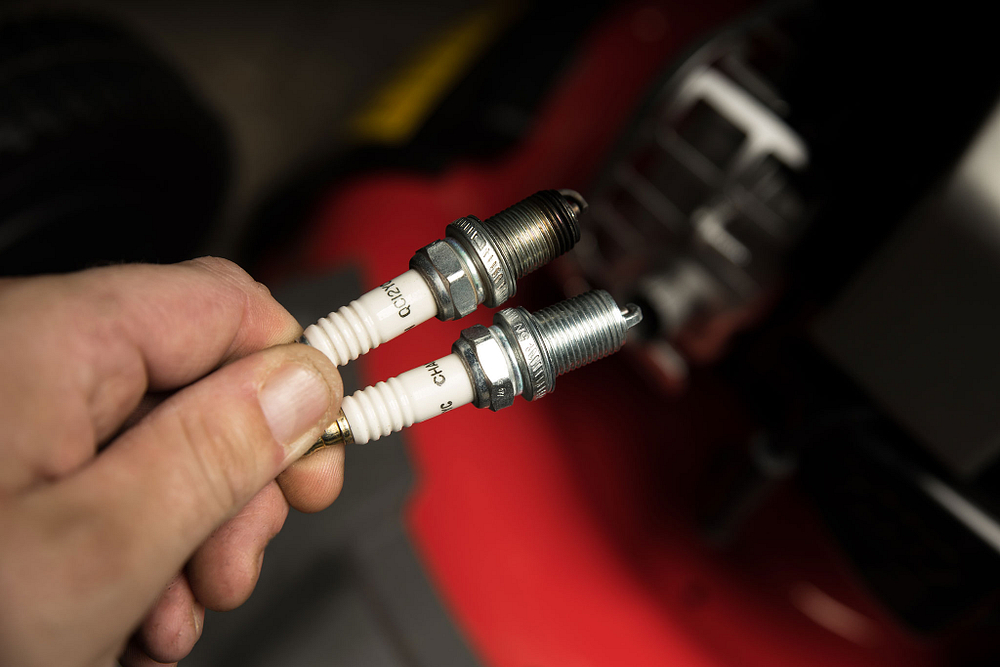Spark Plug & Ignition System Maintenance
This FAQ covers the essentials of spark plug inspection and replacement. It shows you how to use a spark tester and how to adjust and clean a spark plug that is worn but still serviceable. Just remember, you can't go wrong by replacing it.
Spark Plug Operation

The electrodes on a spark plug must be clean and sharp to produce the powerful spark required for ignition. The more worn or dirty a spark plug, the more attempts pulling the rope may be necessary in order to produce an adequate spark.
If you haven't tuned your engine recently and have to repeatedly pull on the rewind to start the engine, a damaged spark plug may be the culprit. Inconsistent firing, known as spark "miss," can result in sluggish engine operation and poor acceleration. A damaged spark plug may also cause excessive fuel consumption, deposits on the cylinder head and oil dilution.
Luckily, a spark plug is one of the easiest engine components to repair and an inexpensive one to replace. And your standard socket set may already include the most important tool - a spark plug socket.
Cleaning and Inspecting a Spark Plug
Disconnect the spark plug lead. Next clean the area around the spark plug to avoid getting debris in the combustion chamber when you remove the plug.
Remove the spark plug using a spark plug socket.
Inspect the spark plug for very stubborn deposits, or for cracked porcelain or electrodes that have been burned away. If any of these conditions exists, replace the spark plug.
Use a spark plug gauge to measure the gap between the two electrodes (one straight, one curved) at the tip of your spark plug. Many small engines require a .030" gap. Check our Identifying the correct spark plug and gap FAQ for the specifications for your model or consult with your local Briggs & Stratton Authorized Dealer. If necessary, use a spark plug gauge to adjust the gap by gently bending the curved electrode. When the gap is correct, the gauge will drag slightly as you pull it through the gap.
Reinstall the plug, taking care not to over-tighten (15 ft. lbs. MAXIMUM). Then attach the spark plug lead.
Replacing a Spark Plug
- Locate the spark plug(s). If unsure where it is, consult your Operator Manual or the example images below.
- Once you have located the location of the spark plug(s), remove them with a spark plug wrench (part 19576S).
- To confirm the correct spark plug(s) for your engine, consult your local dealer. Have your model type trim (MTT) and engine serial number ready.
- Once you have the new spark plug, check and adjust the gap if needed.
- Install the spark plug with the spark plug wrench (see directions on the back of the packaging).
- Consult your Operator Manual for details on how often to change your spark plug.
Many engine performance problems can be linked to maintenance issues such as stale fuel, dirty air filter, fouled spark plug and degradation of the oil. A great way to help avoid these problems would be to perform an annual tune-up using a Briggs & Stratton engine Maintenance Kit.
.jpg)
Checking Ignition With A Spark Tester
A spark tester offers an inexpensive, easy way to diagnose ignition problems. If you find a problem, remove and inspect the spark plug. Replace the spark plug if you find evidence of wear or burning at the spark plug tip. Spark plugs are inexpensive and a new one may solve the problem.
- Connect the spark plug lead to the long terminal of your tester and ground the tester to the engine with the tester's alligator clip.
- Use the rewind or electric starter to crank the engine, and look for a spark in the tester's window.
- If you see a spark jump the gap in the tester, the ignition is functioning. The absence of a visible spark indicates a problem in the ignition system.
Checking For Spark Miss
A spark plug that is fouled or improperly gapped may not allow sparks to jump the gap between electrodes consistently. The spark plug will fire erratically or may occasionally fail to spark. Test for this problem - |
known as spark "miss" - if your engine stumbles, with a noticeable decrease in engine sound. Spark miss can also cause the engine to emit black smoke or a popping sound, as unburned fuel exits with the exhaust and ignites inside the muffler.
For additional information, please visit our Ignition Troubleshooting FAQ. |
Warning: Please read and abide by any applicable Safety Information contained in your engine Operator's Manual. The material provided above is not intended to replace work performed by a Briggs & Stratton Authorized Dealer. Terms and Conditions apply to all of the information presented on this website. Always be sure to completely read and understand your engine Operator's Manual.
MORE INFORMATION
Have more questions? Ask our new tool, Briggs & Stratton Assist for fast and accurate answers.
LOCATE A DEALER
Finding the right dealer is key to getting the right help. Our dealers are certified and specialize in selling or servicing our different product types.






